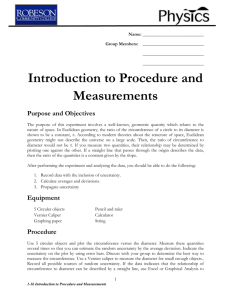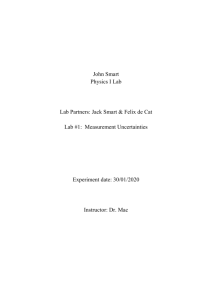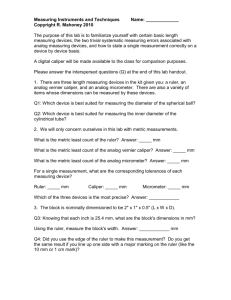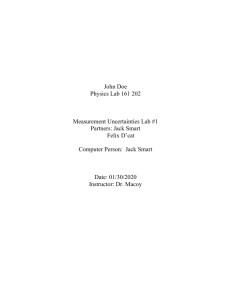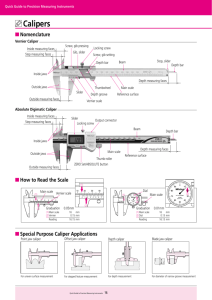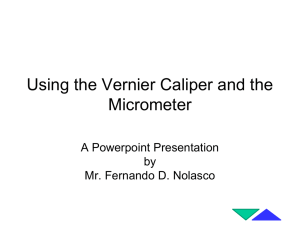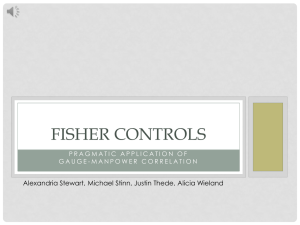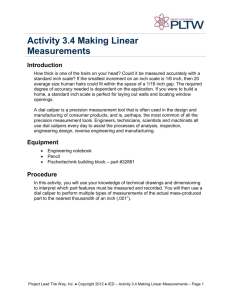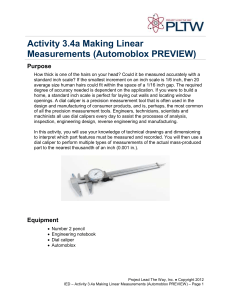Experiment #1 - Department of Mechanical Engineering
advertisement
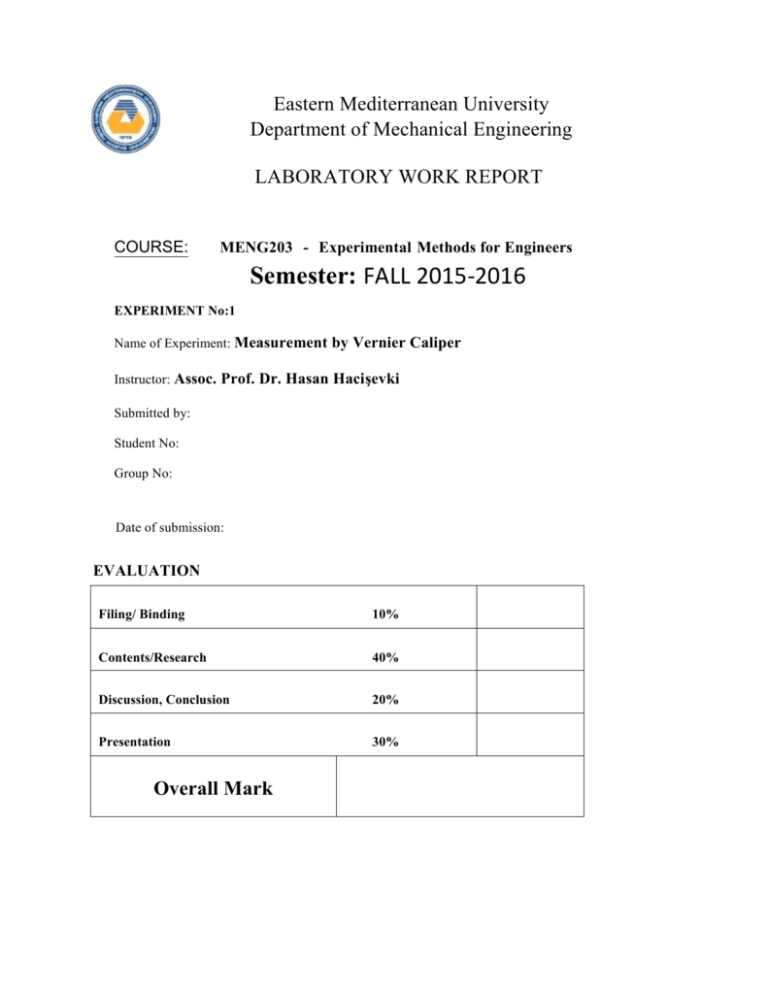
Eastern Mediterranean University Department of Mechanical Engineering LABORATORY WORK REPORT COURSE: MENG203 - Experimental Methods for Engineers Semester: FALL 2015-2016 EXPERIMENT No:1 Name of Experiment: Measurement by Vernier Caliper Instructor: Assoc. Prof. Dr. Hasan Hacişevki Submitted by: Student No: Group No: Date of submission: EVALUATION Filing/ Binding 10% Contents/Research 40% Discussion, Conclusion 20% Presentation 30% Overall Mark Introduction A Vernier caliper is a precision instrument that measures internal dimensions, outside dimensions, and depth. It can measure at an accuracy of one thousandth of an inch and one hundredth of a millimeter. The caliper has 2 sets of jaws on the upper portion and the lower portion. Each set of jaws has a fixed jaw and a movable jaw. The upper set is designed to measure inside dimensions. The lower set is designed to measure outside dimensions. It also has a depth probe at the base or rear part, which functions as a depth measuring tool. Types of Scales There are 2 scales on a Vernier caliper. The main scale is typically found on the length of the caliper. It functions much the same way as a ruler. The main scale is fixed on the device and cannot be moved. The caliper also has a movable Vernier scale. The Vernier scale is the secret to the instrument’s precision. It is divided into 10 sets, each of equal length. Below are the best uses for a Vernier caliper. 1. Measuring Inside Dimensions The upper set of jaws on the caliper can be used to measure inside dimensions, such as the diameter of holes on a piece of wood or metal. Measuring the precise diameters of holes in pipes, cylinders and other hollow objects is very important to any project or application. The jaws of the caliper can be easily slid into the hole to get the precise measurement. The caliper can also be used to measure inside dimension of holes with different shapes, e.g. square, rectangular, cylindrical, or hexagonal. Lastly, the upper jaws can be used to measure the distance between 2 objects. This can be done by simply putting the jaws of the caliper between the objects to get a measurement. Measuring Outside Dimensions The lower set of jaws on the Vernier caliper can be used to measure outside dimensions. Outside dimensions include the outer diameter of a cylinder and total length of an object. The outer diameter of cylindrical objects can be measured by simply clamping the lower jaws of the caliper around the object. The Caliper can also measure the length or width of an object by placing the object between the caliper’s jaws. Procedure: In this experiment, we measured the inner and the outer diameter (mm) of 10 rings with vernier caliper and recorded the data in the given table. In this report I am going to calculate average dimensions and statistical analysis such as mean, standard deviation and uncertainty analysis. Then I will use the error propagation formulas to compute the uncertainty in quantities derived from the measurements. Then I will discuss and interpret the results. RESULTS Inside diameter (mm) (𝑥𝑖 − 𝑥𝑚 ) (𝑥𝑖 − 𝑥𝑚 )2 1 2 3 4 5 6 7 8 9 10 𝑛 1 𝑥𝑚 = ∑ 𝑥𝑖 𝑛 𝑖=1 ∑𝑛 (𝑥𝑖 − 𝑥𝑚 )2 𝜎 = √[ 𝑖=1 ] 𝑛 𝑉𝑎𝑟𝑖𝑎𝑛𝑐𝑒 = 𝜎 2 outside diameter (mm) 1 2 3 4 5 6 7 8 9 10 (𝑥𝑖 − 𝑥𝑚 ) (𝑥𝑖 − 𝑥𝑚 )2 Uncertainty Analysis: 𝜎 Uncertainty = ((Standard deviation) / (Number of reading))0.5 = √𝑛 Uncertainty for inner diameter = Uncertainty for outer diameter = So, Inner diameter = Outer diameter = Standard Error = 𝑆𝑛 = 𝜎 √ = √[ 𝑛 Standard Errorinner = Standard Errorouter= Discussion of Results 2 ∑𝑛 𝑖=1(𝑥𝑖 −𝑥𝑚 ) (𝑛)(𝑛) ]
